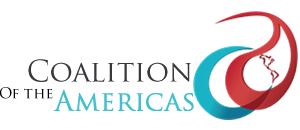Program Report
Knowledge Management and Transfer 2024
OVERVIEW
A LIFE-LONG LOCAL COMMITMENT
NMOs are founded by interested local parties committed, and frequently dedicated for life, to improving the attention people with clotting disorders in their countries.
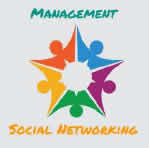
These local leaders are well aware of the present situation, the challenges to be met, and how to accompany each one of their members.
Likewise, NMOs have the support of COA and the World Federation of Hemophilia, which accompany their local consolidation, understand specific situations, and are aware of their commitment to the community.
COA has aimed to undertake a long-term project for the American communities with clotting disorders on the principle of treatment sustainability for all, depending on the level of development of each NMO.
Therefore, the «Knowledge Transfer» course as an accompaniment of the selected NMOs will be the first step towards empowering each cornerstone in America. Throughout the last decades, every person involved has been relevant to achieving the objectives both specific and general in each organization.
In this context we ask ourselves, Are the young and the elderly two kinds looking at different places within an NMO? In recent years COA has acknowledged the need for starting a transfer process of knowledge and values between pioneers/founders and new members. There is no abyss between them nor are they two “civilizations” incapable of communicating. We only need to facilitate mutual understanding and intergenerational dialogue based on non- hierarchical conversation as a human connection that builds trust.
METHODOLOGICAL APPROACH AND POPULATION SURVEYED
Two data collection tools have been used:
- A semi-structured Survey Form (with open and closed questions) sent to the 26 NMOs that are part of the COA.
- A course on Knowledge Management, Transfer and Administration addressed to the NMOs, which allowed for the exchange among the different tiers in each organization (leader, members, and volunteers- youngsters).
This information enabled a qualitative study based on said diagnostic tools, with the following characteristics:
- Target Population: NMO members (leaders, volunteers) and people selected to take the course on Knowledge Management, Transfer and Administration.
- Geographic area: Countries in America.
- Time: Between May and July 2024, surveys and course exchanges were completed.
The survey mode was the assisted self-administration of the questionnaires sent by COA members. Although surveys were individualized with the name of the sender, it is worth pointing out that the answer and final delivery of questionnaires was performed individually, without assistance from any COA member, so that each organization could speak out freely. This measure enhanced the quality of the reported data and opinions.
For analysis purposes, WHF material was used: the Annual Global Survey and World Clotting Disorders Registry, as a framework for the samples and information completion provided by the Organizations. Probability sampling 1 was used for the “leaders/pioneers” and “successors” groups.
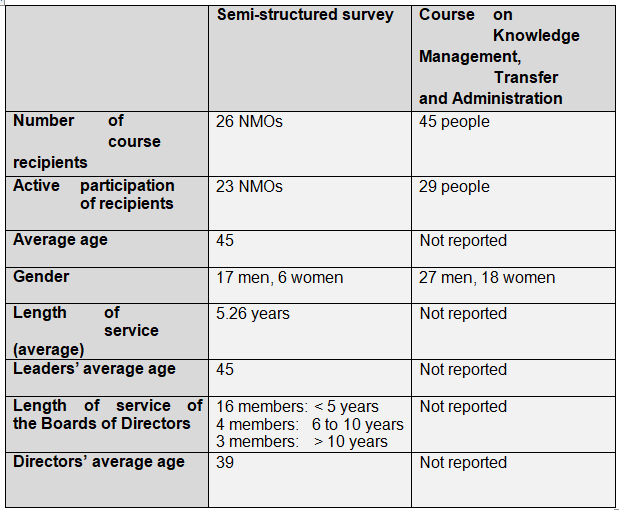
1 Probability sampling is a sample selection method that assures the randomization and representativity of the sample
.
People providing information through both data collection tools have the following characteristics:
- Organization leaders have been in charge of their NMOs for between 1 month and 15 years and show the basic knowledge necessary for accomplishing their tasks, except for two cases (Peru and Trinidad-Tobago), as well as knowledge of culture and institutional history.
- Five (5) out of twenty-three (23) organizations have leaders who have held office for more than ten (10) years, personifying the history of difficulties and characteristics of the NMOs.
- Eighteen (18) out of twenty-three (23) organizations have leaders with less than four (4) years in office, which indicates that access to relevant positions within the Organization by members and/or volunteers has been made easier.
- The average age of those entering the organizations is 39, mainly as volunteers; later they become members and eventually hold a position in the Board of Directors.
- Regarding the leaders, those of five (5) organizations average sixty (60) years of age. In eleven (11) organizations, leaders average forty-five (45) years of age. Out of the remaining reporting organizations, six (6) of their leaders average thirty-three (33) years of age.
DIMENSIONS, PERSPECTIVES, and STUDY APPROACH
Both the Questionnaire and the Course were designed to address some of the dimensions relevant to the main issue in the NMOs, i.e. the absence of transition between “leaders/pioneers” and “new leaders”.
On the one hand, it was important to survey matters related to the situation and conditions of each NMO. Inclusion of young people, women, and volunteers among their members and organization structure was especially relevant. These factors were grouped in a first dimension in the survey and later, by means of several practical works, they were studied in depth in the course.
On the other hand, the leaders’ views regarding their organizations were sought, as they were qualified and experienced in their significant roles and therefore able to provide inside information. It is worth stressing that although the leaders’ opinions were always subjective, the course allowed us to appreciate an «objective» contrast in the NMOs and identify their level of commitment to COA and WHF guidelines. In this second dimension, it was relevant to survey the NMOs’ present conditions and above all to learn, by means of practical works, the way members/volunteers taking part in the course project the future.
Finally, the third dimension includes the perception of the present situation (generational gap) and that of the future knowledge transfer processes and generational handover, as well as the difficulties and conditioning factors implied therein.
In sum, according to the protagonists’ perspective about life within the organization that enabled them to become professionals in the management of people with clotting disorders, through COA and WHF as well as the pharmaceutical industry, it does not seem that these «pioneers» are agreeable to the idea of the imminent transition stage, the end of their function as NMO leaders, and a change in their role within the organization.
In this interrelation, COA as well as WHF and the pharmaceutical industry are specifically concerned about the handover of responsibilities and accrued knowledge to the new generations of NMO members and volunteers. As is well known, the vicissitudes of each organization and the incidence of each leader have greater or lesser effects when said leaders have to leave their position hastily due to unexpected factors, as has happened.
The data and testimonies in this report account for this, and are a vibrant call of attention both to COA authorities and WHF as well as the community involved in clotting disorders, regarding the present situation of the NMOs related to control handover which, in some cases, might seriously compromise the NMO functioning and services.
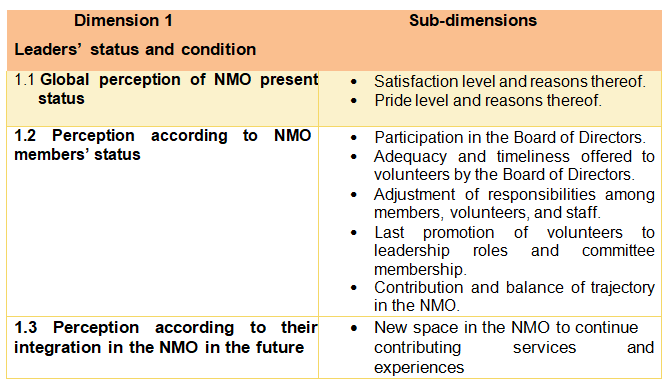
.
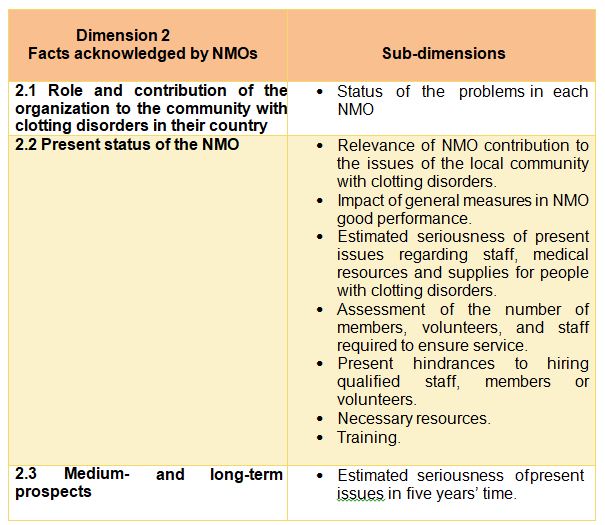
.
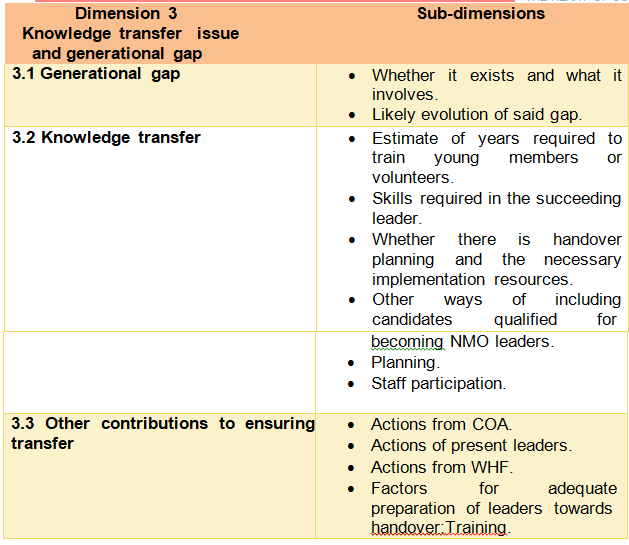
.
EXECUTIVE SUMMARY OF THE STUDY
This study included twenty-three (23) surveyed organizations that address clotting disorders in America, take part in COA, and are National Member Organizations acknowledged by the WHF. It also included fifteen (15) organizations that took part in the Knowledge Transfer course, with members and volunteers qualified for addressing the matter of succession and changes in organization paradigms.
It is worth mentioning that both the survey and the course tackled intergeneration issues affecting the organizations at present and the gap between NMO pioneers and the young. The latter is a matter of concern regarding the proper transfer of knowledge between both generations. The main findings appear below.
In sum, the young are making a resounding and anguished call of attention to the leaders, Boards of Directors, and older volunteers for them to start a thriving and determined support of the strengthening of the young’s skills in various matters: not only do they want to actively participate but also to have a voice and vote.
DIMENSION 1 – LEADERS’ STATUS AND CONDITION.
- The average score of NMOs according to the questionnaire and the survey was 40 over 100. This average shows an interest in the organization’s development and roots, but also that they are still not quite able to amalgamate its parts.
- Five (5) NMOs reported that the new goals proposed by COA and WHF were positive and enriched their organizations’ growth and local consolidation. They also considered the increasing inclusion of young people at different levels of the organization as an opportunity.
- Eight (8) surveyed organizations admitted not having a strategic plan known by the community. Two (2) deemed it necessary to introduce such a plan.
- In most cases, course participants have stressed the importance of having a positive “leader” that shows strength in the face of challenges, learns from his or her failures, and encourages teams to do the same. Thus, successors should be a model for improvement and the achievement of future objectives, even at difficult times for the local community with clotting disorders.
- Leaders answering the survey pointed out and emphasized the work of members and volunteers of their organizations as much as that of medical teams and staff accompanying the local community with clotting disorders.
- During the course it was possible to identify the fact that many of the tasks undertaken by NMOs are carried out amid criticism, which hinders their local development and performance. In broader sense, when NMOs have had to face commitments out of the country (exchange with other organizations, participation in congresses, etc.), they have difficulty achieving objectives and deviate from COA’s common goals.
- Out of the fifteen (15) countries enrolled in the Knowledge Transfer course, ten (10) accessed COA’s Education Platform with more than twenty-five (25) participants in the synchronic classes, showing interest in the matter but reporting difficulties at the time of accessing contents. This denotes that NMOs take advantage of both mode and opportunity but sometimes their contexts and environments are not uniform and there are disparities among organizations and members; consequently, soft content courses should be adjusted to each local reality.
.
Data obtained in the NMO survey show a tendency towards the inclusion of young leaders: eleven (11) NMOs representing 48% of the total have a Youth Committee formed by between two (2) and five (5) members. When asked whether members between eighteen (18) and thirty-five (35) have taken part in WHF and COA training sessions and workshops, 100% of said organizations answered affirmatively. But when these eleven (11) organizations were asked whether members between eighteen (18) and thirty-five (35) received training to work in their NMOs, three (3) answered negatively.
It is commendable that the twenty-three (23) NMOs, especially those that boast a Youth Committee, deem it important to increase young people’s participation in training and workshops, identifying strengths and encouraging them to take part in projects.
- In that sense, when the leaders surveyed have been asked for their opinion about the existence of members capable of being their successors, their answers have been as follows: 100% have said that knowledge transfer is indeed important; 50% report the inclusion of young people in their organizations; 26% answered negatively, and 38% see this matter as transversal but lack a Protocol or line of action to carry out the succession process.
- The course has evidenced each leader’s commitment to their young and the likelihood that these “new leaders” should implement critical thought and active participation. Only 13% of the total organizations have been able to carry out an unconditioned and thorough SWOT matrix and implement it methodologically. Twenty-two percent of the total organizations have identified Strengths, Weaknesses, Opportunities, and Threats sporadically but without a critical analysis of the best ways to revert both Weaknesses and Threats. The remaining 65% considered organizational introspection an unnecessary action and were indifferent towards this proposal.
- Last but not least, the leaders/founders and those with more than ten (10) years in the Board of Directors show resistance to exchanging positions with their members or volunteers between eighteen (18) and thirty-five
(35). Said leaders represent 13% of the total organizations and despite looking favorably upon the inclusion of young members, they relegate them to secondary positions in the organization. This situation is replicated in 100% of the total organizations when asked about the age of their Board of Directors, which ranges between thirty-five (35) and forty-five (45). It is worth mentioning that in 61% of NMOs the number of Board members ranges six (6) to ten (10); 26% have less than five (5) and only 13% have more than ten (10).
- By drawing a comparative parallel with course attendance levels, it is possible to see why some organizations have been more proactive towards change than others and the way their leaders deem organizational growth hand in hand with the young necessary, understanding that inter- and trans-generation work leaves nobody behind; on the contrary, it enhances knowledge in each of the members and volunteers in the NMO.
DIMENSION 2: FACTS ACKNOWLEDGED BY NMOs
Teaching the course allowed us to see clearly what the role and contribution of the organizations are towards the community with clotting disorders in their respective countries, and how relevant the influence of the State is in the achievement of their goals. On performing the SWAT matrix as well as the strategic SMART plan as a SWAT, more than half the NMOs found the State accountable for the problems they have to face, mainly due to their dependence in the short-, medium- and long-term. Two (2) out of every five (5) organizations foresee the actions of the Ministry of Health in their countries, in the short- and medium-term, as a problem for early detection and fair access to treatment. The effect of government measures, in general, related to the community with clotting disorders is of high impact. Everyone has stated, to a greater or lesser extent, that they have connections with and access to the decision-making authorities, but at the time of measuring impact among patients, the extent of their involvement is negative, detrimental, and in some cases, devastating. Although 80% of the NMOs have connections with some stratum of the State involved in public policies for people with clotting disorders, they cannot say that said policies are the expected ones or the most efficient for the community they represent.
Along these lines, five (5) out of every ten (10) organizations submit technical reports to the authorities that make decisions about the purchase of medicinal products, but when it becomes clear that not everyone (men, women, children) has access to the correct medication, the impact is clearly not the expected one.
- Course participants see that those taking part in the lobbying actions aimed at strengthening the commitment of local leaders are “arbitrarily” chosen, without seeking consensus of members and volunteers who “push for transformation”; and in view of the scarce level of exchange, the possibility of getting successful results becomes much harder.
- Seventy-five percent of the organizations expressing these views have received with pleasure the information provided about key concepts in clotting disorders, medical care principles, therapeutic products, purchase models (bidding processes), and training in economics. However, in spite of the time invested, the expected successful results are often not achieved due to difficulties in trans-generational handover.
- In a broad sense, we believe that founding or pioneer leaders have handed down to the present generations some “must be”s and ‘”status quo”s that cannot be modified as they are considered a “legacy stated by emotions, beliefs, behaviors, and habits”.
- For this reason, two (2) out of every five (5) NMOs are promoting the creation of spaces for the young and, likewise, all of them agree that it is paramount to form committees with women participation, not as ‘carriers’ but as individuals rightfully entitled to receive integral care and access to treatment as any other person with clotting disorders.
- Nine (9) out of ten (10) participants in the course have stated that the founding leaders, pioneers, or current managers have an “altruist profile”: they are committed and available, and offer their assistance either personal or economic, but lack the necessary empathy with the community as a whole.
- Eight (8) out of every ten (10) participants in the course have put forth that there should be an economic incentive for NMO members and volunteers responsible for securing access to adequate diagnosis and correct treatment for both men and women. They are aware of budget restrictions in their organizations but consider that it is very difficult to carry out improvement actions without full- or part-time commitment to the achievement of their goals.
- Currently, one (1) out of every two (2) NMO volunteer members has a training profile, varied interests, and good knowledge of Third Sector organizations, but is not allowed a voice by the decision makers. The same happens with the young, as four (4) out of every five (5) NMOs find it difficult to get in touch and attract them to the fulfillment of their goals.
- Youngsters (Generation Z – 1999 to 2012) attending the course have shown good perception of the mission, vision, values, and goals of their organizations, but think they should be more dynamic, updated, and closer to the realities they are faced with. They are interested but not usually committed.
- On the contrary, Generation X (1965 to 1980) see as a vital point the shaping of a cycle leading to age integration: each stage should end handing down a legacy to future generations.
- Chairmen of 22% of NMOs have held their position for more than ten (10) years; 50% have a Strategic Plan known by all members and state the need for including continuous improvement management actions: out of that group, 60% delegate the task to the Board of Directors, 20% to the WHF, and 20% to groups of young people.
- It is worth mentioning that 80% of organizations have stated that they have a succession line and, consequently, an operative Youth Committee, but with only a short number of members: two (2) to five (5) youngsters between eighteen (18) and thirty-five (35) years of age; and only one (1) out of every five (5) organizations includes these volunteers in the training sessions provided by WHF or COA.
- When this matter was analyzed for all the organizations surveyed, we found that 65% of NMOs have provided their young between eighteen (18) and thirty-five (35) with some kind of training towards work in their organizations. Even so, 74% deems it necessary to “develop a training program for the future leaders of the NMOs”.
- By contrasting survey results against effective participation in the course, we are able to affirm that only 14% of the NMOs surveyed have included in their ranks young people between eighteen (18) and thirty-five (35); and only one (1) out of every nine (9) has allowed them to analyze the organizational structure and suggest improvements without the intervention or ‘supervision’ of the chairman or leader.
- Thirty-five percent of NMOs have at least five (5) people receiving monetary remuneration for the development of a variety of tasks, with the exception of the medical staff.
- Regarding healthcare professionals, 92% NMOs have stated that they work in their organizations as volunteers, and the remaining ones have paid staff (4%) or no healthcare professionals at all in their NMOs (4%). Clearly, the figures above indicate that nine (9) out of every ten (10) organizations do not function as Hemophilia Treatment Centers for patients, with paid medical staff.
- It seems evident that the most controversial issues in the NMOs are hiring staff and integrating members and volunteers to the staff for the development of key positions. This evidences a reality mainly related to the organization funds, and has an impact on the commitment and social integration of members at economically active ages.
- Asymmetry between volunteers and staff implies that generations ‘Y’ (1982-1994) and ‘Z’ (1994-2009) have the least commitment possible whereas generation ‘X’ (1965-1981) has a dilemma between economic needs and the need for “a better quality of life” that an active participation in the organization might provide. Meanwhile, the Baby Boomers (1945- 1964) or Builders (1928-1945) develop their activities within the NMO with no concerns because their economic needs are met, they have a lot of time in their hands and are committed to the ‘cause’, which not always coincides with that of the community.
- We are able to assert that within the NMOs there are generations devoted to ‘putting out fires’ but they make knowledge transfer difficult, so the young, unable to enter the organization as paid staff, have to prioritize making a living thus withdrawing from volunteer action. This lack of integration is also detrimental to the specific tasks that these youngsters between eighteen (18) and thirty-five (35) could perform for the NMO, as professional commitment in this global capitalist system demands a certain economic remuneration beyond the fact that everyone is pursuing the same goals.
- To the facts identified above such as the increasing generational gap and the absence of new members and/or volunteers between eighteen (18) and thirty-five (35), or the instability of the latter within the NMOs, we must add, as a key factor, the time necessary for training a volunteer and/or member boasting those unique features required to end up later becoming a member of a Committee, a Director on the Board, or the organization leader. This difficulty increases with the ‘bureaucracy’ within the NMO that seeks to slow down the creation of spaces for the young for fear of
granting them the chance to replace the leaders-founders. They are not
envisaged as an opportunity for improvement and this poses a serious
problem for the organizations in the medium-term.
- Accordingly, 70% of the leaders surveyed said that the number of volunteers in their NMOs is less than five (5) (53%), or between six (6) and ten (10) (47%), which is not enough to ensure continuity of the NMO knowledge according to the average incidence of the population (0.90%) presenting clotting disorders in the Americas.
- Lack of incentives appealing to diverse profiles of young people is still an unsolved, and in some cases very difficult, issue. In recent years, very few have embraced the proposals (Youth Committees). A solid 78% think that there are NOT enough young people to guarantee succession; 26% stated that their organizations do NOT have enough staff trained to carry out the tasks performed at present by the leader and the accompanying Board of Directors. Only 39% said that their organizations had enough committed and prepared young people.
- Exchange during the course evidenced that the main obstacles faced by NMOs (96%) are low funds, lack of a physical space of their own, difficulty to find professionals that base doctor-patient relationship on the moral obligation of the physician to relieve suffering and respect the patient’s beliefs and autonomy, instead of prioritizing the relationship between themselves and the pharmaceutical and healthcare technology industries without taking into account the specific needs of the population with clotting disorders.
- The course was a forum for an intense debate on medicinal products, their social demand, and the quality of life they grant to people with clotting disorders. Fifty-eight per cent of participants have stressed the attitude displayed by treating physicians in American countries, who have not been capable of understanding that a patient that receives the correct treatment generates social value “besides adding years to their life and life to their years”.
- Seventy per cent of course participants have asserted that the State plays a twofold role in its relation to the pharmaceutical industry and therefore, to a medicine life cycle, on the one hand as a regulator and on the other as the main customer. About the latter point, 100% of participants have agreed on the relevance of the NMOs being trained to accompany the State for better decision making in this regard.
- Four (4) out of every six (6) organizations surveyed, confirmed by participants in the course, agreed that young volunteers performing some kind of task in their NMOs could have the necessary time to design improvement plans but that the main limitation thereto is not only the need for funds but also the lack of decision from the people in charge, leaders and Boards of Directors, to give this age group of eighteen (18) to thirty- five (35) the space to assume a more active role.
3: DIMENSION KNOWLEDGE TRANSFER AND GENERATIONAL GAP
- Both the survey and the course have showed the existence of a generational
gap, clearly defined as “the difference in specific knowledge”.
- For 96% of NMOs Knowledge Transfer is meaningful and valuable, that is why at present 33% of them have young people between eighteen (18) and thirty-five (35) as volunteers. Likewise, all the organizations have agreed on the value of including women and migrants in terms of the actions of the organization as a legacy.
- Exchange forums during the course left no doubt about the negative impact of losing a leader without having a well-prepared successor. The counterpart of that is the clearly positive impact made by a leader who trains his or her successor, and once he or she steps aside, they become the new leader’s “consultant”.
- NMO leaders’ reports during survey and the works of the participants in the course show discrepancies. Indeed, three (3) out of every five (5) participants have confirmed the existence of a marked generational gap that not only influences the way of managing the organization but also the actions and proposals developed.
- According to the survey conducted, and taking the course as an example, it was possible to identify the lack of “intermediate generational cohorts”; NMO members share their well-defined characteristic, i.e. clotting disorders, but are unable to come together as an organization with a given goal over time. This study, conducted under two different methodologies, had two subject groups: on one side the leaders-mentors, and on the other a non-exposed group (volunteers, members). The exchange level was observed throughout time and interventions. Both groups have interests in common but regarding communication, methodology, and topics, a solid 70% do not support the same action lines.
- We are stressing this point because it is essential that COA realize that there is a generation or demographic cohort, i.e. a population group born over the same period of time hence having similar experiences and consequently sharing attitudes and a given way of seeing the world, that NMOs are not taking into account.
- This division into generations is particularly useful when analyzing the way vital experiences interact with the biological cycle of a NMO, including this American event or relevant economic and technologic changes.
The chart below illustrates the above.
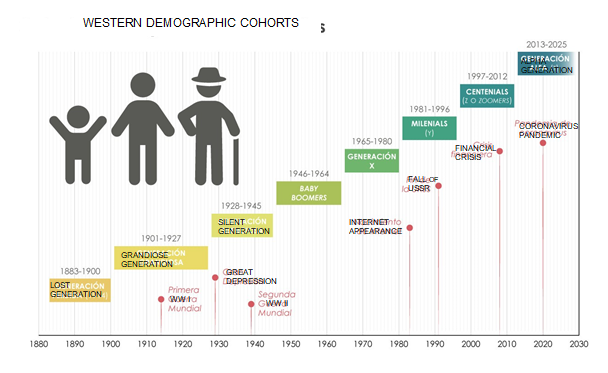
.
- Along this same line, survey respondents as well as course participants understand the relevance of generational integration and the serious trouble lack of it can cause in the future: the absence of incentives to keep young volunteers in the organization. However, those who have been in charge of the NMO for longer than five (5) years show no interest in encouraging these new leaders, nor have they established any length of time the organization estimates that a youth will need to be prepared if he or she aspires to a seat on the Board or to take the reins. Everyone agreed on the need for a plan; some claimed they already had one, or mentioned who should be replaced, but 75% of course participants showed partial or total ignorance about what their leaders’ or Directors’ purposes were.
We can see that in one (1) out of every (3) NMOs young volunteers feel frustrated with their leaders or Boards of Directors. This shows in their passive commitment.
- Five (5) out of every seven (7) organizations attending the course emphasize the need for their present leaders or Directors to have a proper balance between theoretical and practical skills. Along the same line, the survey shows that most of the organizations deem it necessary to “prepare new leaders”, which according to them implies the following:
- An adequate knowledge of the operation of the organization
- Command of the skills pertinent to the activity they intend to perform (Chairman, Board member, among others)
- Motivation, dedication and commitment
- Teamwork skills
- Continuous training in the matter of clotting disorders
- Being somehow related to clotting disorders
- Continuity in the organization
- It stands out that there is a dichotomy between survey results and course productions related to the existence of a plan or systematic and approved methodology to transfer the knowledge of older NMO members to “a new leader” or “young volunteers”.
The reasons offered were the lack of planning in the matter and especially the absence of committed volunteers, the fact that “young people” do not prioritize the NMO, and insufficient members of the new generations to replace the old ones.
It has also been said, both in the survey and the course, that knowledge is transferred by “attending congresses, meetings, and lobbying”, but they argue that the “new generations” have not been able to take part in COA and WHF activities. Notwithstanding, course participants consider these instances essential as they combine theoretical and practical elements.
Those who have attended the course and completed all its stages also say that the projects submitted, generally by young people, are discontinued or applied without method by the leaders and, in some cases, they are not even taken into account by those in intermediate positions such as the Boards of Directors.
- Forty percent of the NMOs surveyed stated that as they do not have young people with the profiles required to hold leading positions, they are going through a critical situation regarding replacement. Lack of the specific knowledge required was particularly stressed.
- In spite of the above, 100% of NMOs stated that their organizations, in one way or another, are drawing plans for knowledge transfer in the medium- and long-term. During the course it was possible to confirm that the participants’ technical knowledge has been acquired voluntarily, sometimes due to their professional training, and in very few cases by opportunities granted by the leaders to take part in training activities related to projects, analysis, or updating. For many participants, this was the first formal specific training meeting about organizational topics.
- In order to achieve knowledge transfer and the ability to keep the young in the NMOs, surveyed respondents have expressed, each one in their own way, the following needs:
- To ensure training by opening participation in courses, congresses, and/or different kinds of meetings in America.
- To prioritize the place of young people between eighteen (18) and thirty-five (35).
- Continuous training within the NMO, developing local and regional strategies related to the early detection of clotting disorders and ways of attaining better treatments in the country.
- To grant institutional acknowledgement by means of various incentives.
- To fund the implementation of programs addressed to the young.
- To provide spaces within the NMO for young people between eighteen
(18) and thirty-five (35) aimed at encouraging knowledge exchange, development, and technology.
- To promote the actions of “young leaders” by making said actions known to the community with clotting disorders, both at local and regional levels.
Main Results
To respond to this dimension we shall use, in the first place, the answers to the question, “How well do we know ourselves?” given by leaders, pioneers, or chairmen of twenty-three (23) organizations (Argentina, Bahamas, Belice, Bolivia, Brazil, Chile, Colombia, Costa Rica, Cuba, Ecuador, Honduras, Jamaica, Mexico, Nicaragua, Panama, Paraguay, Peru, Dominican Republic, Surinam, Trinidad and Tobago, Puerto Rico, USA, Uruguay, Venezuela), and add the contributions of the different countries during the “Knowledge Management, Transfer and Administration” course in the sub-dimensions. There were forty-five (45) participants from fifteen (15) NMOs (Argentina, Bolivia, Brazil, Chile, Colombia, Costa Rica, Cuba, Ecuador, Honduras, Mexico, Panama, Peru, Dominican Republic, Uruguay and Venezuela), and 60% of NMOs also answered the corresponding end-of-course survey.
.
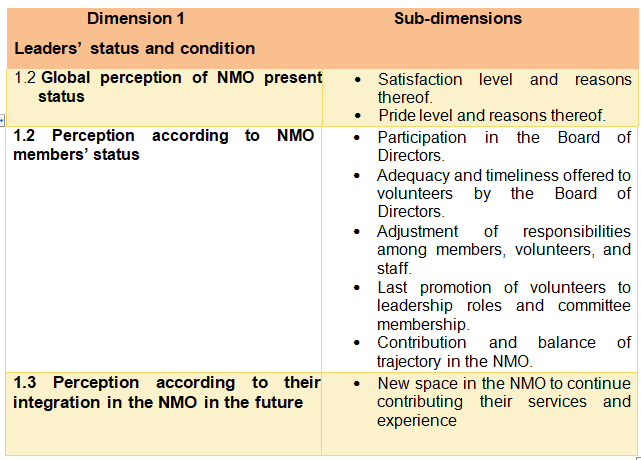
The level of satisfaction with their NMOs had an average score of 8.92 points over 10. Members over fifty (50) years of age, therefore with longer trajectories in the NMO, show higher levels of satisfaction averaging 9.5 points, whereas the age group between forty (40) and forty-nine (49) evidence a slight decrease in the level of satisfaction averaging 8.66 points.At present,
what is your level of satisfaction with your NMO?
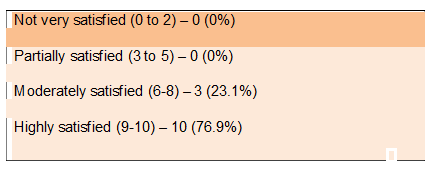
Regarding reasons for satisfaction, 83.8% mention the human qualities (kindness, compassion, honesty) of the group in their organization; 60% of women see this as more relevant than other options whereas only 50% of men identify it as a reason for satisfaction.
It is worth mentioning that the ratio of women to men in the organizations is 61.5% to 38.5%.
According to age groups, the choice above is made by 14% of the <39 group, 57% of the <50 group, and 29% of the <60 group.
Reasons for the level of satisfaction
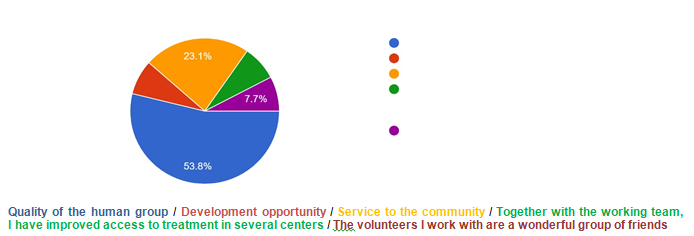
Regarding how proud they are of their organizations, 84.6% show a high level of belonging, which makes them feel really good. It is an essential factor to the commitment of members and contributors, a percentage to be fostered by inspiration and teamwork by improving communication and taking advantage of strengths.
One NMO showed a decrease in this regard, with only 15.4% of members feeling moderately proud. This negative tendency can increase if internal human factors are not taken care of.
How proud are you of your NMO?
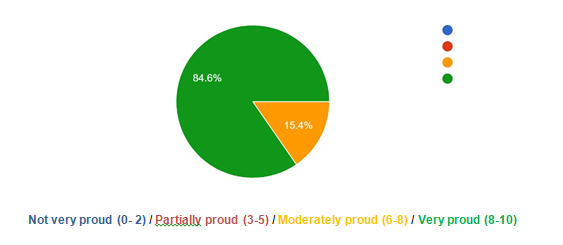
The reason why 38.5% of members have chosen the option “The institution works for the benefit of the community” lies on three (3) factors: 60% of women mentioned this; a 100% are between forty (40) and sixty (60) years of age and lastly, 80% hold positions in the organization (chairperson or Board director).
Reasons for the level of pride
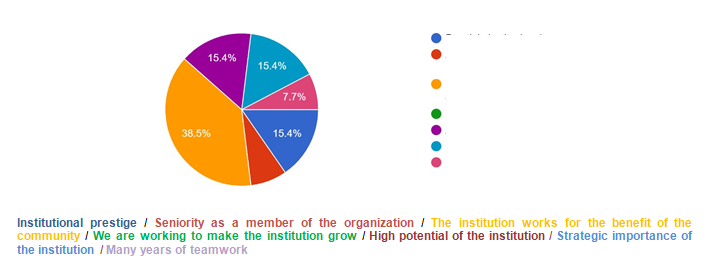
In this section related to personal growth and professional progress within the NMO, 76.9% have answered affirmatively, presenting two (2) main factors for analysis: 30% are women and 46% are men; average age is forty-four (44), i.e. “X generation” individuals.
Digging in the X generation from the sociological point of view will allow us to understand the behavior of the organizations in general. The “X gen” is between the baby boomers and the millennials. Any description is perforce a general approximation but useful for this study’s global analysis.
- They are usually children of the silent generation and/or the baby boomers
- They represent 18.2% of the present human population
- They have witnessed huge changes in the world and a marked decrease in the birth rate.
- They had to endure serious economic difficulties in childhood and early adulthood, so they are considered crafty and resourceful in the face of adversity.
- They are the first generation of the digital and IT revolution.
Having said this, it is easy to understand why 23.1% of participants chose not to answer.
Do you notice any personal and/or professional growth and progress in the NMO?
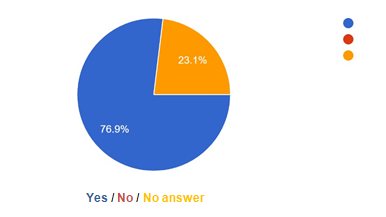
Following the logic of analysis, those who said that the latest professional growth occurred in the last ten (10) years respond to three (3) factors: gender, age, and level of satisfaction with the NMO.
Meanwhile, those who answered that growth had occurred throughout the present year (61.5%) respond to two (2) factors: they are the current chairperson (57.14%), out of whom 25% are women, or their age ranges from forty (40) to (50) years (66.6%).
According to 30.8 % of respondents, growth has occurred in the last one (1) to five (5) years. This answer is mainly given by women (75%) ranging fifty-one (51) to sixty (60) years of age.
When do you feel your last personal/professional growth within the NMO occurred?
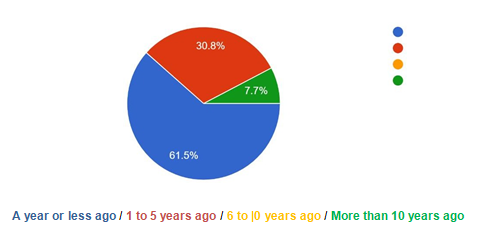
What is your position in the NMO?
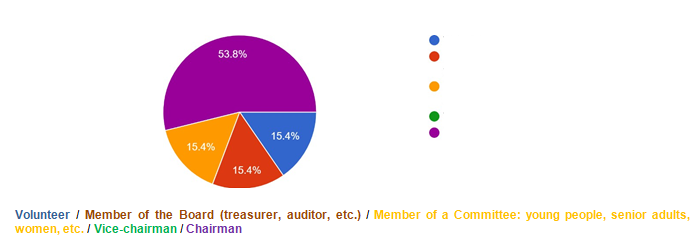
Hereunder we have analyzed the subjective aspect of NMO members and the way they identify “opportunities” and “training”, understanding both concepts as an exercise that might vary according to the role of teacher or student but is revealing about the way the organization members want to be regarded.
From this perspective, it is worth stressing that out of the sample of NMO members, no-one stated that their opportunities have been nil. Answers increase gradually from 7.7%, few opportunities, to 30.8%, some opportunities. However, a vast majority of 61.5% claim that they have been presented with many training opportunities.
It is important to cross this last datum with gender, age, and position within the NMO:
- 25% of women have had training opportunities
- 75% range from forty (40) to fifty (50) years of age
- 62.5% are currently chairpersons.
Those who claimed having had few or some opportunities have the following characteristics:
- 60% are women
- 60% range from forty (40) to fifty (50) years of age.
- 60% are currently volunteers
Has your NMO granted you opportunities to take other courses?
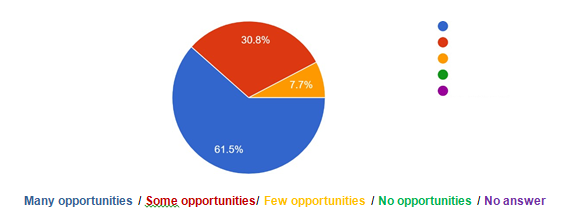
Beyond growth opportunities, training for skill development, and opinions about each survey respondent’s position, it is striking that all of them, men and women of all ages, agreed that they are satisfied with the place they hold in the organization. This means that chairs, Board members, and volunteers are a hundred percent in agreement with their organizations’ planning.
All of the above is consistent with the levels of pride and satisfaction showed by NMO members in America. However, their leaders must take the remaining members’ needs into account, as in the majority of cases (92.3%), personal and/or professional growth occurred in the last five (5) years.
This means that, in the short term, the NMO situation and current model should be analyzed; they should also determine what people they want or are able to involve with a view to achieving dynamic, effective, and efficient management and keep up these high levels of approval.
Are you satisfied with the place you hold in your NMO?
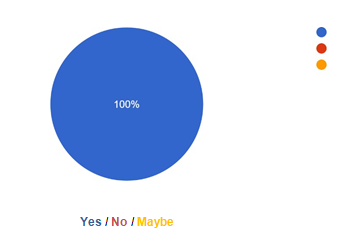
It is clear that 77% of NMOs have been able to convey their passion and mission to their members given that this high percentage represents members with more than six (6) years (30.8%) in the organization, and 23.1% of members with more than sixteen (16) years of service, who still keep their hopes high and continue making efforts to add more people to the community. At this point, leaders should focus on the organizational structure, the steps necessary to prepare succession, and the identification of inactive members.
How long have you been part of the NMO?
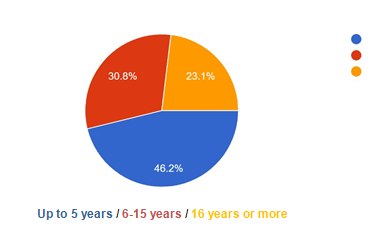
The three following charts depict public and financial recognition to those performing tasks in the NMO; although some organizations are able to operate without money, all of them need funds and human resources.
When speaking about resources we refer to the members’ time devoted to performing actions for the organization: design of materials, web page, efficient distribution of funds, and travelling availability.
It is essential that the NMO reflect on the best way to raise the necessary funds and make sure that their use be 100% aligned with its mission, vision, and values.
It is useless to set as our goal saving all the children with clotting disorders in our community if we lack members to accomplish it.
It is high time we asked ourselves what we need. The answer seems to be always money but even so, we invite you to ask yourselves, money for what? It could be to pay volunteers for their time or healthcare professionals for their work, or hire someone to manage the social media, or rent a space of our own. If we see any of these as a recurring need of our organization, how do we get the funds?
The fact that 76.9% of NMO members do not believe their responsibilities should be remunerated does not imply that we should ignore the 30% who do believe they should get financial compensation. And when asked the same question, 38.5% acknowledged the need for a “financial compensation to members and volunteers for the time they devote to the organization”.
When first approached, most members said that non-profit organizations should not devote themselves to raising funds for their expenses but when the same question was asked again in a different way, the initial negative fell from 76.9% to 61.5%,
This means there is a tendency to transform “charity members and volunteers” into “professionalized members and volunteers”, seeking to balance efforts and make decisions towards the NMO development.
Of course there is a public image to be preserved and above all, made known, but recognition to members and volunteers is a relevant psychological component that allows for a healthy relationship among the NMO vision, mission, and goals and its members.
By means of these actions, the leader would show that he or she values the time everyone devotes to the organization so that it may function, provide treatment for the patients, and pursue new horizons every day. Thus, he or she would give due worth to the loving commitment of parents, siblings, grandparents, uncles and aunts in their unrelenting struggle for a better quality of life for those with clotting disorders.
Do you think your responsibilities in the NMO entitle you to monetary remuneration?
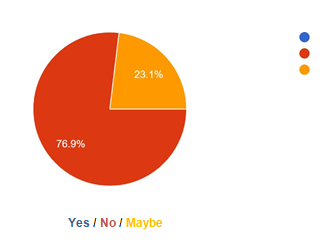
According to the tasks you perform, should you receive some kind of financial incentive?
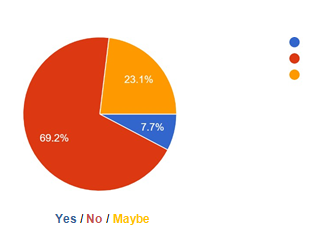
Do you think it is important that the NMO acknowledge the time devoted by members and volunteers by means of financial compensation?
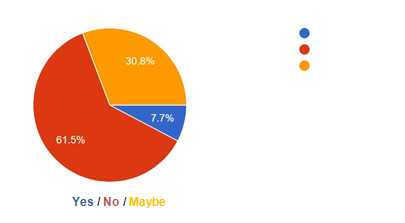
This section broaches matters related to the progress of members and volunteers along their time in the NMO. Although 38.5% have reported that they have contributed positively to the organization goals, 30.8% have emphasized the matter of the young. This is related to the fact that 46% of NMOs taking part in the course have a Youth Committee.
Last but not least, 23.1% feel they have “contributed to the community” with their time at the NMO, which reflects the huge challenges those with clotting disorders have to face. Clearly, NMOs’ activities are absolutely necessary both in underdeveloped and developed countries.
All the organizations surveyed support the idea of “treatment for everyone”, a better world in which the rights of all people with clotting disorders be guaranteed.
Looking back, what has your history in the organization been like?
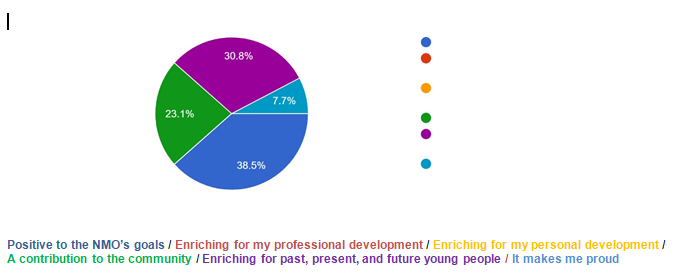
.
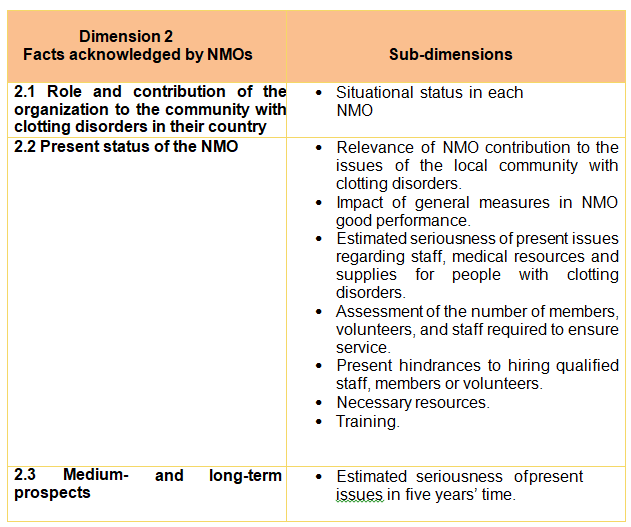
This dimension broaches the NMO’s situational status, as these organizations are essential to report and raise awareness, both of society as a whole and of decision-makers, about the problems affecting people with clotting disorders, among which the inequality in the access to diagnosis and treatment.
These challenges require citizen awareness and participation, so the action of NMOs as mobilizing agents is indispensable.
Sixty-seven percent of the NMOs taking part in this exchange have identified their situational status: with a medium-term outlook (less than five (5) years), 76.9% consider their situational status to be balanced, 7.7% see a serious situation, and 15.4% a moderately serious situation.
How do you see the situational status of your organization in the medium term?
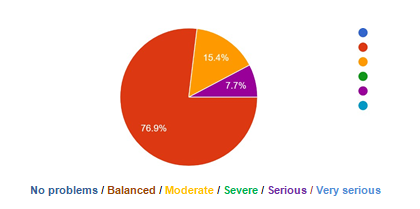
Consistently with the image above, in the one below 75% see the future of their NMOs as balanced in the short term; but the idea of an unstable future decreases and 25% of respondents see the status of their NMOs in a moderate state of trouble instead of a serious one. It is interesting to observe the way the emphasis is placed on one side or the other.
How do you imagine your NMO in the next five years?
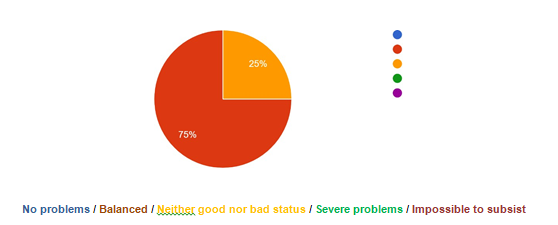
What is your perception of the influence of your country’s internal issues on the well-being of your organization?
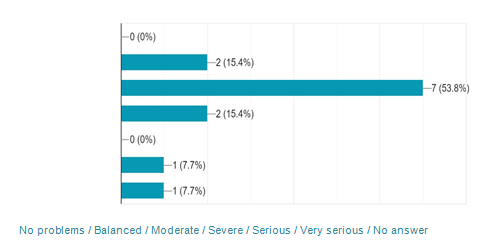
How important is your NMO’s contribution to Government decision-makers?
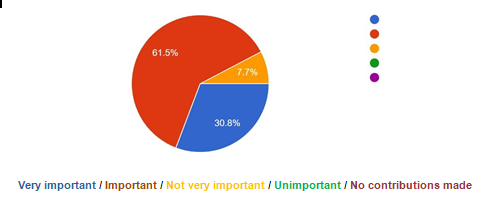
Where does your NMO budget come from?
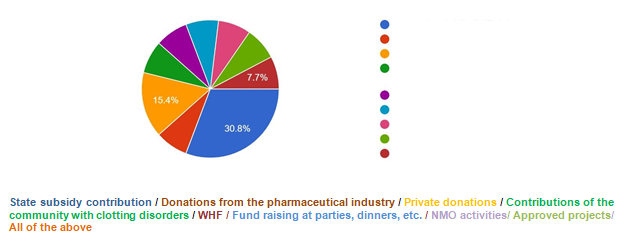
In the medium-term, do you think your NMO would improve with a larger budget?
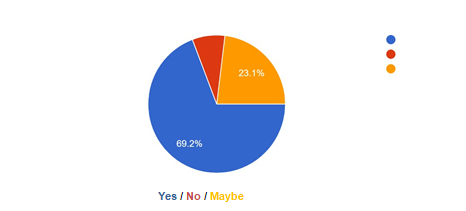
Have you thought about a strategic budget plan from a perspective of information democratization?
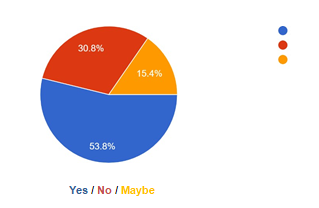
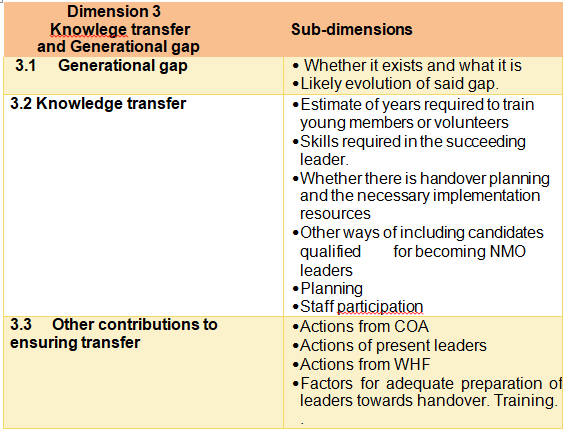
If you had to draw a Succession Plan in your NMO, where would you place the present leader?
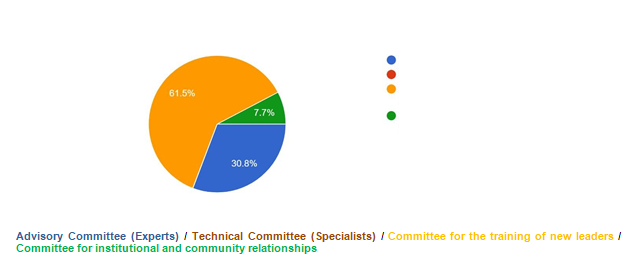
What issues should your NMO address to achieve an adequate succession?
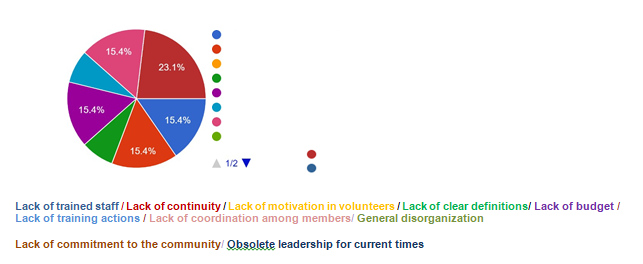
How do you imagine your NMO in the next 5 years?
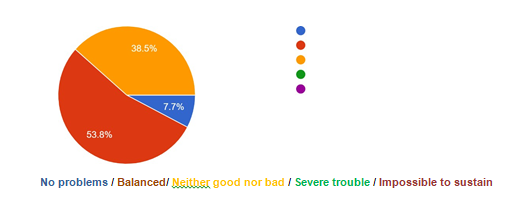
In the next 5 years and with the action plan, what difficulties do you think your NMO will have been able to overcome?
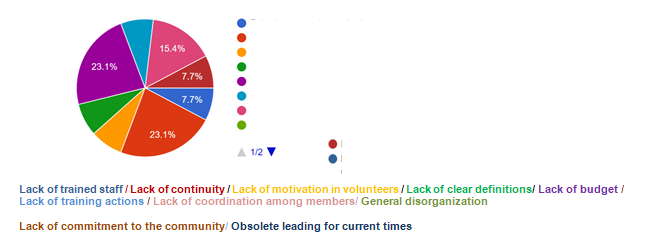
In the next 5 years and with the action plan, what difficulties do you think your NMO will have been able to OVERCOME for an adequate succession?
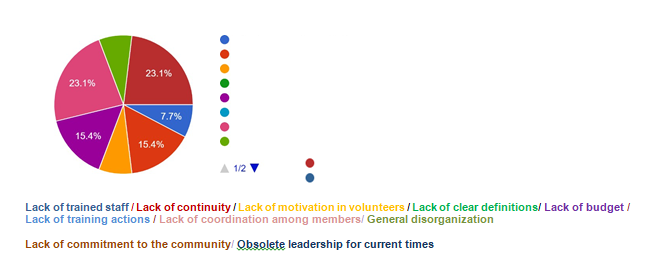
What do you think about the number of people in your NMO?
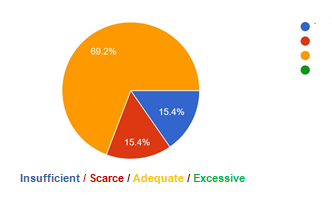
Do you think your NMO should integrate young people between 18 and 35 in the next 5 years?
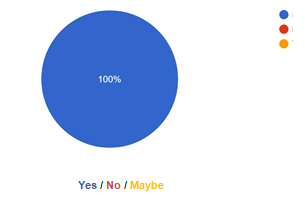
At present, do young people have enough available time to take part in the NMO structure as volunteers?
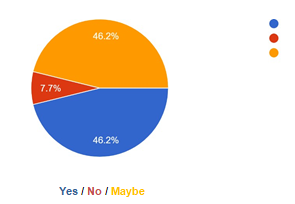
Do you think the NMO has enough offers to attract young people from the community?
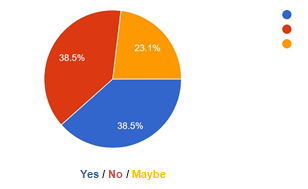
Taking into account the module dealing with the generational gap, How do you define the inclusion of young people in your NMO?
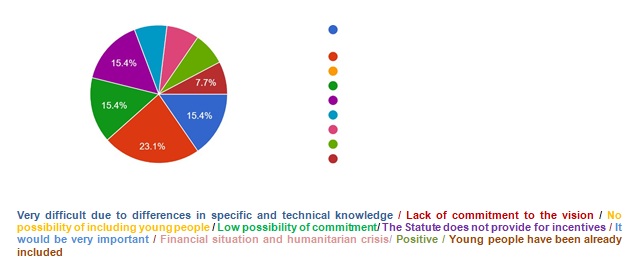
Hypothetically speaking, if there is indeed a “generational gap” in your organization, what effect do you think this will have in the medium-term (5 years)?
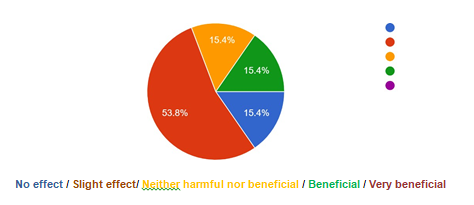
Again hypothetically, if the “generational gap” has existed in your NMO for several years, what effect do you think this will have in the long-term (10 years)?

What methodology do you consider more appropriate for knowledge transfer?
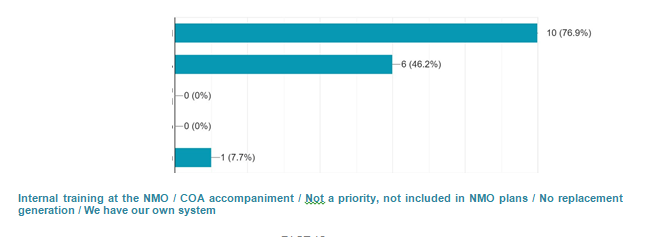
From your point of view, what factors should be taken into account to prepare a “successor”?
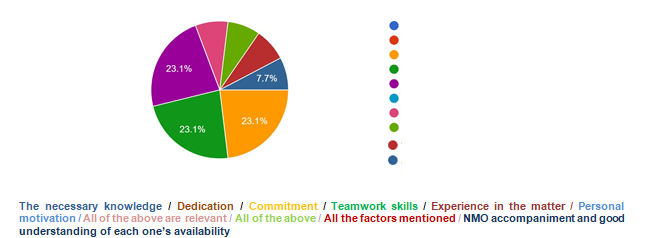
.
.
Conclusions
Sixty-three percent of active participants in the course have decided to “create a new organization” or “become a positive leader”. Both challenges are huge, with great responsibilities and many demands.
This initiative to start talking about Knowledge Management, Transfer and Administration within the organizations gave fifteen (15) NMOs the chance and the privilege to start seeing themselves differently and speak out about the new challenges posed by clotting disorders in their countries.
At first the organizations broaching the matter of rare conditions such as clotting factor alterations, with a low incidence in the population, saw the term ‘leadership’ as something vague. However, as the course progressed, they were able to understand that ‘leadership’ is not reserved solely for large companies. Being in charge of an NMO does not imply becoming a leader automatically, nor does being a leader imply automatically understanding the practical steps leading to the creation and management of an organization.
The survey revealed a tendency to consider the ‘manager’ as the ‘leader’, to the point of seeing both terms as exchangeable. Actually, we may say prima facie that being a leader or a manager in an NMO is quite different; both tasks are very significant and need to be coordinated.
Leaders are visionaries. They are capable of visualizing the way they want a project to look, feel, and be implemented and the same happens regarding the organization, its members, and even those without a voice.
Leaders chart the route to turn visions into realities. The twenty-three NMOs surveyed as well as the fifteen countries taking part in the course have serious difficulties developing these “leadership” and “management” concepts. Forty-seven percent of course participants mentioned that “leaders” do not identify the “manager” as a member who accompanies the vision, optimizes funds, and aims at the same specific goal.
In 87% of NMOs, the leader and the manager are the same person
That being said, it is worth stressing that 65% of course participants, among them some leaders, expressed the need for leaders to think creatively to attract new volunteers and members, especially between eighteen (18) and thirty-five (35) years of age.
Along these lines, with 100% of practical works delivered, NMOs should assess their organizations’ standing right now and determine how far they want to go, using a strategic plan that democratizes knowledge. Although there are some well-established organizations, the foregoing is valid for all NMOs: they should stop, reflect, assess, change, and improve to attain growth.
Both the survey and the course enabled us to analyze, study, and work on NMOs in different situations: consolidated, growing, starting up, and emerging. In this sense, we found leaders who “remain”, others that simply “are”, and many that would like to “add”.
Regarding “pioneers”, both in the 23 NMOs surveyed and the 15 taking part in the course, there were leaders that just “survived or still survive their position”, others “able to achieve a good work”, and others that “left” for natural reasons or by choice.
It is worth mentioning that at the time of putting advice and experiences together, not all the leaders in the NMOs surveyed and participating in the course expressed the wish to “grow together with the members in their organization”. Only 8% talked about “ways that lead to success and the importance of acknowledging the mistakes that lead to defeat to avoid making them again”, and that “not everything is a success”.
Throughout this period of analysis we have been able to observe all the wheeling and dealing involved in managing a non-profit organization: how to start, how to appoint a board of directors, how to enroll patients. In this sense, we also analyzed the need showed by many NMOs to reinvigorate their present organizations. Lastly, we have observed that some “mature” organizations are achieving very little, both inside and outside.
We told the organization attendants that they should stop focusing on “charity”; they were surprised when we proposed a change of term, substituting “clients” for “patients”. We have seen that, according to the leaders’ profile, they need to change to become efficient in their services and programs. The so-called “charity”, based on leaflets and begs for assistance or favors, does not help in the achievement of the goals sought by the World Hemophilia Federation and the Coalition of the Americas.
NMOs need to seriously reflect about themselves, using an Action Plan, Strategies and Policies in the short-, medium-, and long-term. “For profit” should not be seen as negative for the “non-profit” aims. In a global world, the Third Sector in this XXI century requires an alchemic change.
An all-encompassing definition featured in a world healthcare magazine defines “globalization” as a process of economic, political, social, and cultural integration becoming increasingly wider and more complex that happens when the capital, goods, people, ideas, images, values, environmental toxins, and even microorganisms cross State boundaries.
NMOs belong in the “Third Sector”, i.e. the group of civil institutions that are neither government nor state, nor do they belong in the world of enterprises dealing with markets and business. They carry out a solidarity action as organizations formally constituted to render services and benefits to those suffering from any form of coagulopathy.
The twenty-three (23) organizations surveyed as well as the fifteen (15) taking part in the course share a similar pattern: they are private (not public), self-governed, and do not produce or distribute any profit among their members, whose work is voluntary in most cases and only exceptionally remunerated.
Out of the twenty-three (23) NMOs dealing with clotting disorders, 98% are centers of support, promotion, and social action, and by means of training courses and workshops share techniques and working modes with their target community. Likewise, 66% publish and distribute documents, manuals, and leaflets on specific matters relevant to said community.
.
Closing remarks
We have concluded that the twenty-three (23) NMOs are heterogeneous, complex, and multiple. Any attempted description should not oversee the special features of the actors involved, especially their leaders, Boards of Directors, members and volunteers. They are also different in size, shape, management system, and scope of services, to name just a few ones.
Therefore, despite being immersed in a global context, their strategies cannot be the same if they seek to adjust to the new paradigms with success. Diagnosis and treatment vary widely among regions in America, depending on the socioeconomic situation of each country.
Focusing on Latin America and the Caribbean, in low-income countries most people with clotting disorders are not diagnosed and many suffer a premature death for lack of treatment. To address their basic needs it is necessary to have basic knowledge, diagnostic capability in a timely manner, and offer proper treatment, all of which are scarce in underdeveloped countries with poor health infrastructure.
Regarding clotting disorders, Latin America and the Caribbean constitute a region of great opportunities, with endless stories of fortitude and creativity shared by participant NMOs at the Knowledge Management, Transfer and Administration course. It is a region that never stops and transforms itself as many times as necessary to face adversities.
According to the reports, WHF and COA have been working for more than four (4) years alongside the pharmaceutical industry, the governments, the private sector and the NMOs to improve the latter’s skills, both soft and hard, inclusion and resilience in view of the change expected in them in the face of new contexts and challenges.
It is appropriate to include the Gini coefficient in this objective analysis, as it not only allows us to understand the NMOs’ behavior but also helps us design the work to be done during this second accompanying stage.
In general, taking into account the twenty-three (23) countries answering the survey, the average rate of poverty is 30.3% and the inequality gap keeps increasing. Also, the region is in the middle of a very significant migratory crisis: more than 7.5 million Venezuelans have left their country towards different places in America, and to that we need to add 3.7 million internal movements.
We have seen that for over twenty years the WHF has collected basic international demographic information and data on resource availability for clotting disorders by means of their Annual Global Survey (AGS). In recent years, they have included the migratory variable.
The WHF’s Annual Global Survey is a Surveillance Project aimed at identifying and characterizing individuals suffering from hemophilia and other rare bleeding disorders all over the world. Its goal is to support better health planning and highlight existent deficiencies.
Applying the latter to the twenty-three (23) NMOs studied, it is clear that they need to stop being managed from the point of view of “charity”, i.e. distributing leaflets and begging for favors, and seek to consolidate their services with a self-financing plan that consider commercial activities and include strategies and action policies. All the organizations that are part of COA and NMOs under WHF share an identical goal which is to improve the life of those suffering bleeding disorders in their community: children, parents, grandparents, spouses, a large community seeking adequate and state-of-the-art treatment.
.
